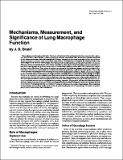| dc.contributor.author | Brain, Joseph David | |
| dc.date.accessioned | 2010-11-10T16:12:24Z | |
| dc.date.issued | 1992 | |
| dc.identifier.citation | Brain, J. D. 1992. Mechanisms, measurement, and significance of lung macrophage function. Environmental Health Perspectives 97: 5-10. | en_US |
| dc.identifier.issn | 0091-6765 | en_US |
| dc.identifier.uri | http://nrs.harvard.edu/urn-3:HUL.InstRepos:4553221 | |
| dc.description.abstract | Macrophages exist throughout the body. They have critical roles in the peritoneal cavity, bone marrow, skin, spleen, liver, and elsewhere. Their migratory patterns, phagocytic behavior, immunologic roles, and secretory potential are pivotal to both defense mechanisms and to the pathogenesis of disease. Macrophages have been implicated recently in such diverse disease processes as arthritis, AIDS, and juvenile onset diabetes. It is important to recognize the existence of other lung macrophages besides alveolar macrophages. Macrophages exist in small and large airways above and below the mucus. They may release chemotactic factors and a variety of mediators. They ingest and degrade antigens and are microbicidal. Interstitial macrophages are in direct contact with the extracellular matrix as well as other cells in pulmonary connective tissue such as fibroblasts. Thus, release of mediators or enzymes by interstitial macrophages can have a profound effect. Pulmonary intravascular macrophages are resident cells within the pulmonary capillaries of some species. They avidly remove particles and pathogens from circulating blood and secrete inflammatory mediators. Finally, pleural macrophages are involved in the fate and consequences of inhaled particles, especially fibers. A key attribute of macrophages is motility. Movement is an essential step in phagocytosis. There can be no particle binding or ingestion unless macrophage-particle contact occurs. To what extent and by what mechanisms do alveolar macrophages move on the alveolar epithelium? We have used optical methods as well as magnetometry to describe macrophage motility. Lung macrophages express an array of contractile proteins that are responsible for spreading, migration, phagocytosis, and the controlled intracellular motions of phagosomes and lysosomes. We have used magnetometric probing of cytoplasmic motion and rheology for both in vivo studies of macrophage function in animals and humans as well as in vitro studies of macrophages. The cytoskeleton of macrophages and resulting motile events are key in understanding the role of macrophages in relation to particle phagocytosis, translocation, and solubilization. | en_US |
| dc.language.iso | en_US | en_US |
| dc.publisher | The National Institute of Environmental Health Sciences (NIEHS) | en_US |
| dc.relation.isversionof | doi:10.2307/3431325 | en_US |
| dc.relation.hasversion | http://www.ncbi.nlm.nih.gov/pmc/articles/PMC1519548/pdf/ | en_US |
| dash.license | LAA | |
| dc.title | Mechanisms, Measurement, and Significance of Lung Macrophage Function. | en_US |
| dc.type | Journal Article | en_US |
| dc.description.version | Version of Record | en_US |
| dc.relation.journal | Environmental Health Perspectives | en_US |
| dash.depositing.author | Brain, Joseph David | |
| dc.date.available | 2010-11-10T16:12:24Z | |
| dash.affiliation.other | SPH^Molecular+Integrative Physiological Sci Prog | en_US |
| dc.identifier.doi | 10.2307/3431325 | * |
| dash.contributor.affiliated | Brain, Joseph | |


